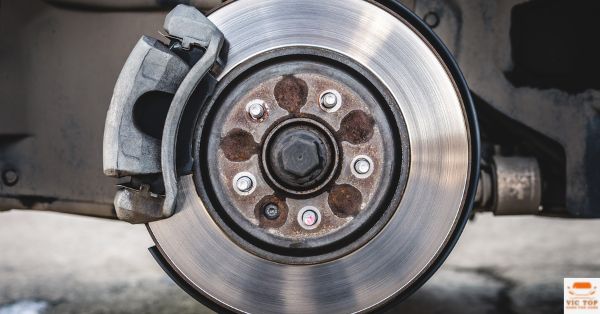Brake pads should be changed after 25,000 to 65,000 miles on average, while rotors should be replaced every 30,000 to 70,000 miles. However, the exact distance may vary based on driving conditions and styles.
The good news is that when your brake pads and rotors are nearing the end of their useful life, you’ll likely notice mild symptoms, making diagnosis and repair simple.
Not sure if your brake pads and rotors need to be replaced? Here are a few signs that it’s time for a replacement.
a). Deep Metallic Grinding Noise
If you notice a deep, low noise that sounds like metal grinding or a rumbling growl, it could mean that your brake pads are eroded and that the backing plates of your brake pads or shoes have made contact with the discs or drums.
If you hear this noise, take your vehicle to a service facility as soon as possible because this metal-on-metal contact can fast cause even more damage to your braking system.
b). Less Than a Quarter Inch of Brake Pad
You can physically examine your brake pads on disc brakes to see if they need to be replaced, though this may necessitate removing the wheels. You will see your brake pads crushed against your brake rotor if you look down on the brake assembly or “caliper” that holds the brake pads.
Consider having your brakes inspected if the friction material on the shoe or pad is less than 14 inches thick (about seven millimeters), especially if it’s been long since your last inspection.
c). Screening or Squealing Noises
When the brakes are engaged, a motorist may hear squealing, screeching, or whining sounds if the brake pads have to wear indicators. A small metal attachment produces this noise on the brake pad backing plate designed specifically for this function.
Wear indicators work the same way as fingernails dragging across a chalkboard do. It’s time to take your automobile to a brake specialist for an examination if you hear it frequently while braking. Remember that not all brake pads have this capability, so don’t rely on sound alone to determine the state of your brakes.
Sur pads may exhibit similar screeching sounds when brakes are exposed to wet, damp conditions, such as after a rainstorm. However, if a sound disappears after the first few times you use your brakes, that’s a good indicator that it was just a bit of moisture on the brake pads or shoes and not a sign they need to be replaced.
d). Indicator Lights
When it’s time to replace your vehicle’s brake pads, some automobiles include an indicator light on the dashboard. Check your owner’s manual to discover if your car has a low-pad warning system installed. If the light does come on, remember that your mechanic will need to repair the warning sensors and the brake pads.
Types of Brake Pads
Different brake pads are made using different materials. The most common materials used are;
a). Semi-metallic Brake Pads
Semi-metallic brake pads are used by most automobiles on the road today. Copper, iron, steel, and other metals are blended with graphite lubricants and other components in the semi-metallic brake pad to help decrease heat build-up.
Because of their capacity to last longer and minimize friction — which helps bigger cars, trucks, and SUVs stop more efficiently — these types of brake pads are frequently seen as OEM options for heavy-duty vehicles.
b). Organic Brake Pads
Originally, brake pads were constructed of asbestos, a strong but poisonous material connected to various respiratory illnesses. After asbestos was banned, many brake pads were made from carbon, glass, rubber, fibers, and others.
Organic brake pads are usually quieter and have a softer application. However, the biggest disadvantage is that they are short-lived. As a result, organic OEM brake pads are typically found in lighter-weight luxury vehicles.
c). Ceramic Brake Pads
Ceramic brake pads are the most recent addition to the market. They were first offered in the 1980s as an alternative to asbestos brake pads. A hardened ceramic substance mixed with copper fibers is used to make this sort of brake pad.
These brake pads tend to last the longest and apply the softest among the big three due to their unique construction.
The disadvantage of ceramic pads is two-fold. First, while they can tolerate high temperatures, they don’t operate well in cooler climates since the material is susceptible to cracking when exposed to intense cold. They are also the most expensive brake pad type.
Type of Brake Rotors
Brake rotors are also available in different types, which vary with the type of vehicle. Let’s go through them for a better understanding.
a). Blank and Smooth Rotors
The most popular rotor type for passenger vehicles is blank and smooth. Blank rotors are both simple and inexpensive.
On the other hand, some manufacturer-specific blank rotors may be made from recycled steel. For this reason, some blank and smooth rotors do not function as well as other rotor types or survive as long.
OEM rotors contain bigger internal fins, enabling them to cool the brake pads more effectively when squeezed and hence have a longer life.
b). Drilled Brake Rotors
A spiraling design of holes is drilled all through the surface of drilled rotors. The perforations help transfer heat and enable dust and water to escape the surface of the rotor without clogging or affecting the braking system.
Drilled rotors are popular among drivers who reside in wet climates because they aid braking in inclement weather. These rotors, however, do not last as long in high temperatures and are hence not commonly utilized in racing vehicles.
c). Slotted Rotors
Slotted brake rotors have particular slots located around the exterior rotor surface instead of holes. Because these bigger and heavier vehicles demand higher stopping force, slotted rotors are typically used on heavy-duty trucks and SUVs. Slotted rotors are also more preferred by those who routinely haul huge weights in their vehicles.
d). Drilled and Slotted Rotors
Drilled and slotted rotors have spiral patterns of drilled holes and slots around the outside of the brake rotor surface. They are normally used by high-performance vehicles like sports cars.
Such vehicles need top-tier cooling and heat dissipation to achieve phenomenal performance.
We at VIC Top Cash For Cars, Always Ready to Assist You. Anytime. Everywhere. Any Day.
Our Services,
- Car Removal
- Cash For Cars
- Unwanted Car Removal Melbourne
- Cash For Scrap Car Removal Melbourne
- Old Car Removal Melbourne
If you are in Seaford, Victoria 3198 and looking for VIC Top Cash For Cars, below is the best way to visit us.
Contact us
VIC Top Cash For Cars,
2 Rochford Pl,
Narre Warren South VIC 3805
(03) 7035 7828
info@victopcashforcars.com.au


Recent Comments